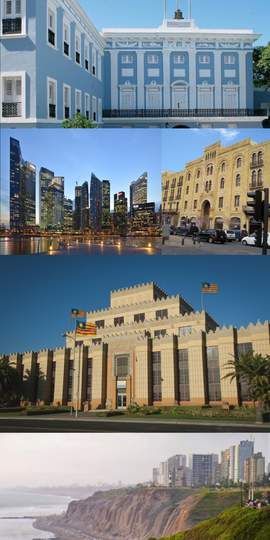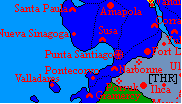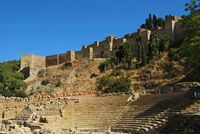Punta Santiago

|
This article or section is a work in progress. The information below may be incomplete, outdated, or subject to change. |
| Punta Santiago Aldurian Capital District | |||

| |||
| Top to bottom: the Executive Mansion, (left) the Campos Business District, (right) the Hotel du Babkha, the Citadel, and the Costa Azul District. | |||
| |||
| Motto: "Libre y Soberana Es Esta Hermosa Ciudad" Martino: "Free and sovereign is this beautiful city." | |||
| Anthem: | |||

| |||
| Map versions | |||
| Official language(s) | |||
| Demonym | |||
| - Adjective | |||
| Government | |||
| Legislature | |||
| Establishment | 1485 AN | ||
| Area | |||
| Population | 9,876,234 (1723 AN) | ||
| Currency | |||
| Abbreviation | |||
| Time zone(s) | |||
| Patron | |||
| Animal | |||
| Drink | |||
Punta Santiago is the capital city of the Republic of Alduria and the largest city in the country. It is located on the Gulf of Susa in the Euran continent, with an estimated population of 943,187 (1684 AN) within the limits of the Aldurian Capital District. Its metropolitan statistical area, which takes into account suburbs and surrounding conurbations, has an estimated population of 2,145,298 (1684 AN).
Punta Santiago is considered the political, cultural, financial, and commercial center of Alduria. Jurisdictionally, the metropolis extends beyond the limits of the Aldurian Capital District mainly within the state of Asuara to the south, and to the west, within the state of Mondego.
Punta Santiago was founded originally as a small port in the then-Kingdom of Babkha called Al-Santyaghu in 1485 AN. Throughout its history it endured the first collapse of Babkha, Ashkenatzi colonization, and later colonization by Leon-Venezia. It was not until the collapse of Alexandria and later Caputia that hundreds of thousands of stateless settlers and developers from both nations came to settle, develop, and populate the city of Punta Santiago as we know it today. Several historical buildings are in Punta Santiago; among the most notable are the city's former defensive forts like the Citadel. Other notable buildings include the Sacre-Coeur Cathedral, the Executive Mansion, the Government House, and the prestigious Hotel du Babkha.
Punta Santiago is also one of the two Treaty Ports established in a treaty with Jingdao. Thanks to its status as a treaty port, it is home to a large Jingdaoese community, mainly ranging from merchants, clergy, and clerks with their families. It is home to the largest Catodral built in honor of the Heavenly Light on the Euran continent. Since Alduria's accession to the Raspur Pact in 1681 AN, trade with Jingdao has diminished while remaining one of the most important sources of economic activity in the city.
History
Coat of arms and flag
Geography
Climate
Cityscape
Architecture
The architecture of Punta Santiago is very diverse and reflects the rich and varied history of the region. The oldest surviving architectural monuments of Punta Santiago are from the Babkhi and Ashkenatzi eras. The remains of the Babkhan ruins of Ithrah, dating back to the era of Babak Shah the Great, of which some artifacts are housed at the National Museum; and the Citadel, a large ziggurat complex which remains from the reign of Gozar Shahanshah.
The oldest part of the city, known as the Alcazaba, mostly features the influence of Babkhi, Ashkenatzi, and Martino architecture. This part of the city is comprised of a network of "setted" roads usually surrounded by ancient, two to four-storied houses built on masonry. Some colonial structures have been restored and serve either as government offices, museums, department stores, prestigious residences, or short-term vacation rentals. The architecture is more varied in other districts of the city. The Campos Business District has rapidly developed since Aldurian independence, featuring a lot of influence from Deco and neo-Babkhan styles, as well as other modern designs.
Punta Santiago is Alduria's primate city and is considered to have the most modernized infrastructure in the country. However, the gentrification of old neighborhoods and the demolition of buildings of cultural significance has caused concerns and backlash from preservationists, historians, and scholars.
Barrios
- Main article: Subdivisions of Punta Santiago.
The 19 barrios that compose the Aldurian Capital District are:
- Alcazaba
- Oriente
- Puebla
- Costa Azul
- Qanavat
- Beauregard
- Monacillo
- Les Artistes
- Quebrada
- Starlight City
- Niavaran
- Sabalan
- Alhambra
- Quimbombó
- Santurce
- Jilin City/Jingtown
- Corozal
- Colorado
- Campos Business District
Alcazaba

The Alcazaba of Punta Santiago is the fortified historic core of the city of Punta Santiago. Within its walls are the core government offices, including the Citadel, a world-famous large ziggurat complex that houses the Department of Defense and other related defense and national security agencies. Located in this district are many national museums and the Plaza de Armas. The Punta Santiago City Hall is also located in this district, along with many of the agencies and offices for the government of the Aldurian Capital District.
It overlooks the Bay of Susa and the Port of Punta Santiago to its south, the Sacre Coeur Cathedral, and the Place d’Etoile to its east, and the Campos Business District and Puebla to the west.
The term “Alcazology” is often used by the Aldurian press to refer mockingly to the study of Aldurian national politics. In the vernacular, "Alacazology" is often used to refer to a piece of commentary, typically produced quickly in response to a recent event, whose primary purpose is to attract attention or wild speculation.
The Alcazaba serves as the designated government district of the city, with the Executive Mansion, Government House, and the Palace of Parliament located inside its walls.
The world-famous Hotel du Babkha is in this historic area of the city, a hotel that often serves as the abode for foreign dignitaries and famous people alike.
Campos Business District

The Campos Business District is a major business district located west of the Alcazaba, the fortified historic core of the city. The district was developed as part of a national public-private development partnership. It is the largest purpose-built business district in Alduria, covering 560 hectares (1,400 acres), with 72 glass and steel buildings (of which 19 are completed skyscrapers), 180,000 daily workers, and 3,500,000 square metres (38,000,000 sq ft) of office space. The Campos Business District is primarily a business district and hosts a population of 82,810 permanent residents and 68,100 students.
The Campos Business District contains many of the tallest high-rises in the city, with the Montparnasse Tower, Kerularios Tower, and the International Trade Center being among the tallest in the district. The International Trade Centre hosts trade fairs and exhibitions such as the Punta Santiago Motor Show held on 24.IX – 1.X every year.
Plaza de Raspur is in the Campos Business District. Plaza de Raspur is the largest shopping mall in the city, known for its variety of international stores and brands. It has 220 stores, 57 restaurants, and a 28-screen movie theatre.
The University of Punta Santiago maintains its main campus in the Campos Business District, as well as the specialized Cotilla School of Business and Economics.
Jilin City

Jilin City, also known as Jingtown, is the Jingdaoese district of Punta Santiago, an ethnic enclave of Jingdaoese people located west of the busy Port of Punta Santiago. It is known for presenting varied architectural structures in the Jingdaoese style, including the largest Catodral in the continent of Eura. The Catodral is a large draw for the followers of the Heavenly Light, enjoying legal protections by local law as a historic and protected building.
The Jilin City rose from the the Treaty of Amity and Commerce, which opened up trade between Jingdao and Alduria. The Treaty established specific Treaty Ports that were opened to foreign trade between the two countries. Punta Santiago was one of them as it welcomed a heavy influx of Jingdaoese and Batavian businesses. The Treaty was signed in 1672 AN.
While the accession of Alduria to the Raspur Pact in 1681 AN did lead to diminished Jingdaoese investment, the city is still a key engine of economic activity in the city. In 1683 AN, a provocative parade led by some members of the Aldurian National Alliance and ethnic Alexandrian leaders of 5,000 people with Aldurian and Alexandrian flags led to the arrest of 5 people that caused damage when confrontations with Jingdaoese residents in the streets broke out. The district is currently subject to added attention from law enforcement to ensure that anti-Jingdaoese violence is prevented.
Jingdaoese Consolidated Benevolent Association
A major component of Jilin City and its community is the presence of its largest family benevolent association, the Jingdaoese Consolidated Benevolent Association (JCBA). The Assocation provides legal aid and financial aid to Jingdaoese immigrants. The association generally provides social support, religious services, religious pilgrimages, death benefits, meals, and recreational activities, especially for older Jingdaoese migrants. The process of membership in these associations is known only to its members, remaining a guarded community secret. The JCBA is often aligned with ethnic Jingdaoese political and business interests and often has a strong influence in local Punta Santiago politics. The JCBA operates the Jing Community Center, known for its intricate and beautiful architecture and for serving as the location of the JCBA and the Punta Santiago Jing School. The building itself is considered the "town hall" of Jilin City.
Les Artistes
Other districts
Demographics
Economy
Tourism
Port of Punta Santiago
The Port of Punta Santiago is a major seaport located in the city of Punta Santiago. It is the largest passenger port and the largest cargo port in Alduria. As of 1683 AN, the Port of Punta Santiago accounts for approximately 300,000 jobs and has an annual economic impact of €43 billion écu.
Culture
Government
Executive
- Governor of Punta Santiago
- Lieutenant Governor of Punta Santiago
- Governor's Cabinet
- Cabinet Departments
- Governor's Advisory Council
Legislative
- Unicameral legislature: the Council of Punta Santiago
- Each of the barrios is a multi-member district, seats apportioned by population?
Safety
- Punta Santiago Police Department
- Punta Santiago Gendarmes
- Punta Santiago Fire Department
- Punta Santiago Special Service - protection of strategic locations, important infrastructure, foreign leaders, and VIPs
Media
Education
Colleges and universities
- University of Punta Santiago
- Punta Santiago State University
- College of Inti
- Aldurian International College
- National War College
Public and private schools
Transportation
Public transport
- Punta Santiago Metro
- CityBus
- Light Rail
- Punta Santiago Streetcar Lines
- Punta Santiago Central Station
Health and utilities
- Carrillo National Health System
- Alexandria Central Hospital
- SantiHealth Hospital
- SantiHealth Clinics
- Punta Santiago General Hospital

